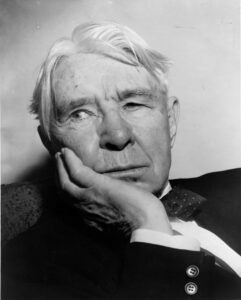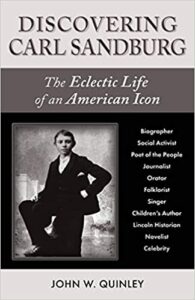
Carl Sandburg, an iconic American, gets a reappraisal
John Quinley’s recently-published book “Discovering Carl Sandburg: The Eclectic Life of an American Icon” is a concise and digestible biography. At 122 pages, this publication is intentionally brief; Quinley notes in the introduction that participants on his tours of the Sandburg historic site are reticent to purchase any of the voluminous and dated treatments of this historic figure.

Carl Sandburg, the prolific and widely-admired poet, Lincoln biographer, reporter, singer, folklorist, critic, and champion of the working class, has largely fallen from public or scholarly attention over the decades since his death.
Western North Carolina audiences may be most familiar with him because of his Flat Rock estate — Connemara — which is now the Carl Sandburg Home National Historic Site. The Illinois-born Sandburg moved here late in life in 1945 and spent his final years in the home. When he died in 1967, President Lyndon Johnson eulogized him as, “more than the voice of America, more than the poet of its strength and genius. He was America.”
While his status has receded since that time, another Illinois native, born a few blocks from Sandburg’s residence and later serving for years as an interpreter at his Carolina home, is resurrecting this American icon.
John Quinley’s recently-published book “Discovering Carl Sandburg: The Eclectic Life of an American Icon” is a concise and digestible biography. At 122 pages, this publication is intentionally brief; Quinley notes in the introduction that participants on his tours of the Sandburg historic site are reticent to purchase any of the voluminous and dated treatments of this historic figure.
“Discovering Carl Sandburg” is organized into 13 chapters, roughly surveying what the author considers the most important facets of Sandburg’s life and legacy. These include sections on his role as a folklorist and a collector/performer of common folk songs, his humorous children’s poems and stories, his great prominence as a speaker and orator, his social activism, as well as a few lesser-known sides of the man.
Quinley mainly examines Sandburg’s life through the lens of his works, with which he displays expert familiarity while largely deferring to select secondary scholarship for insights into his career. Among the best touches is the intimate look at the young boy who grew up in a large, poor family, never finishing high school, but whose curiosity about common people around him led him onward into numerous pursuits.
The author also provides glimpses into Sandburg’s warm and eclectic personality through recollections of friends with whom he stayed. Quinley uses this wide range of friendships, from Eugene Debs to Marilyn Monroe, as well as the array of mourners at his funeral service, to bolster his assertion of Sandburg’s iconic and beloved everyman status. And yes, the famous goats and animal husbandry exploits of Sandburg and his beloved wife Paula are also detailed in the book.
Quinley provides several historian’s flourishes, contextualizing Sandburg’s interest in the plight of the poor and marginalized with a peek into the changing economic/societal trends in the Gilded Age Midwest. He also follows the development of Sandburg’s political philosophy and activism, from socialist writer and reporter to anti/pro-war speaker and front-line correspondent at various times. Likewise, he probes with great interest Sandburg’s historical contribution as a consumed writer and chronicler of Abraham Lincoln’s life and actions in his famed biographical series.
Quinley also provides an interpreter’s touch, connecting readers to the themes that were so important to Sandburg. His great love of nature, which filled his poetry and also his days at Connemara, his appreciation of the folk song before it was considered worthy of academic study, and his outspoken belief in democracy and equality, which he championed throughout his life, all shine in this work. Sandburg once told Edward R. Murrow that the worst word in the English language was, “Exclusive,” because it “(shuts out) a more or less large range of humanity from your mind and heart.”
Trevor Freeman is the Public Programs Director for the Asheville Museum of History.
